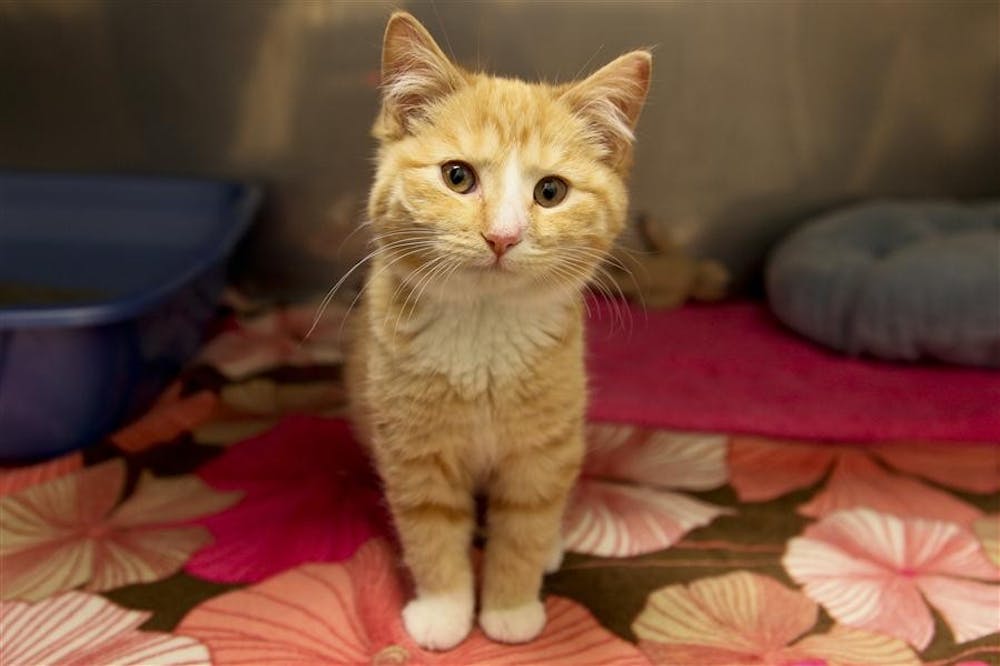Visitors to the Bloomington Animal Care and Control Shelter can pet Abilene, a calico cat, or shake the paw of Luke, a Labrador retriever, just two of 53 animals up for adoption.
The shelter has processed more than 212 adoptions since Jan. 1, striving to ensure each potential adopter will provide a good home for their new pet.
Each potential adoptee undergoes a thorough adoption process, but it’s hard to imagine someone would go through the steps in order to abuse an animal, said Laurie Ringquist, manager of the shelter.
“Very few people that have that intention are bold enough to walk into a shelter and go through that process,” she said. “There’s easier ways to get an animal than to jump through our hoops.”
Yet, that very anomaly occurred recently when former IU student Christopher
Gugliuzza came to the shelter and expressed interest in adopting an orange-and-white cat named Lennox. Gugliuzza stole the cat, leaving past an empty front desk, and is now accused of torturing the animal.
“We want to build relationships built on trust,” Ringquist said. “But we’re not mind readers. Obviously people can lie to us.”
Ringquist said the shelter is now ensuring someone is constantly at the front desk.
The shelter’s security cameras allowed the shelter to quickly identify Gugliuzza.
The adoption process also is a safeguard to ensure pets are being adopted by caring owners.
After adoption paperwork is filled out, staff and volunteers trained to be adoption councilors meet with the prospective owners.
“We ask a lot of questions,” Ringquist said. “It’s really kind of a conversation with the potential adoptee to see if adopting a pet is the right step for them.”
Adoption counselors look for the intentions of the adopter.
“We don’t adopt dogs out to be chained 24/7 or cats to live outside as barn cats,” she said.
The shelter does not conduct a criminal background check as it is not a law-enforcement agency, but it does have its own internal database dating back to 2005.
“We check everyone to see if we have had any negative complaints or if they have a positive history,” she said.
Animal control officers work in conjunction with the shelter, responding to calls and complaints from nuisance barking to animal abuse and neglect.
“There is a very specific definition in city ordinance and state law,” she said. ”We can only enforce the legal definition.”
The local ordinance covers animal care for violations that don’t rise to the state ordinance level, she said, referring to Bloomington Municipal Code Chapter Seven.
“A local ordinance violation, it’s a much less severe, but it’s still a violation,” she said.
Sarah DeLone, education program director for the Monroe Humane Association, said abused and neglected animals are more likely to come from free pet advertisements or pet stores than the shelter, because of ease of availability.
Delone said she helps to promote awareness about animal cruelty and neglect.
“A lot of what we look at and talk about is to promote empathy,” she said. “We talk about respect and providing responsible care.”
One of the reasons animal abuse is such a serious issue is that it tends to be an indicator crime, DeLone said.
“Animal abuse is really important as a social concern, because it often occurs in the context of other violence,” DeLone said. “It’s a lot about power, and it’s a lot about control.”
She said neglect is a more common problem than abuse, however.
“Neglect can be anything from not taking an animal to a vet to not feeding it properly,” she said.
The Association responds to the issue by making education and resources available, such as the shelter’s pet food bank or the Pets ALIVE low-cost spay and neuter clinic,
DeLone said.
“The more knowledge and resources we give to people, I think the less neglect we will see,” she said.
Shelter works to prevent neglect

Get stories like this in your inbox
Subscribe





